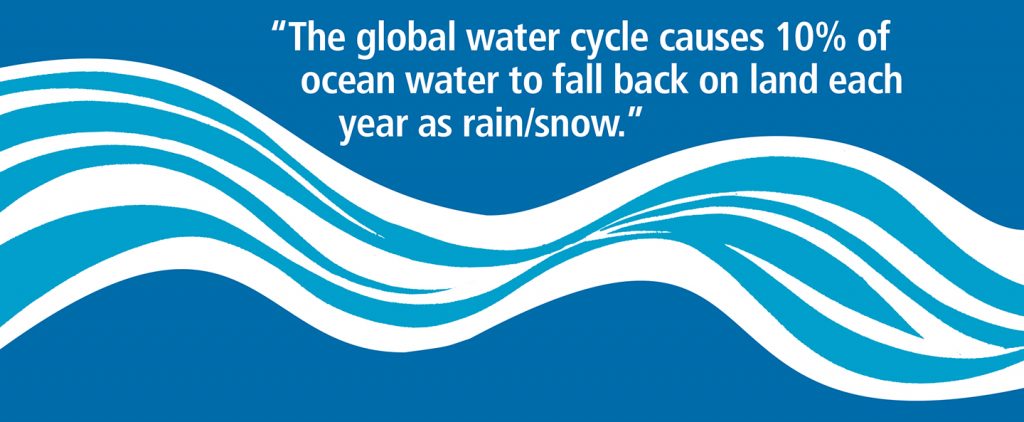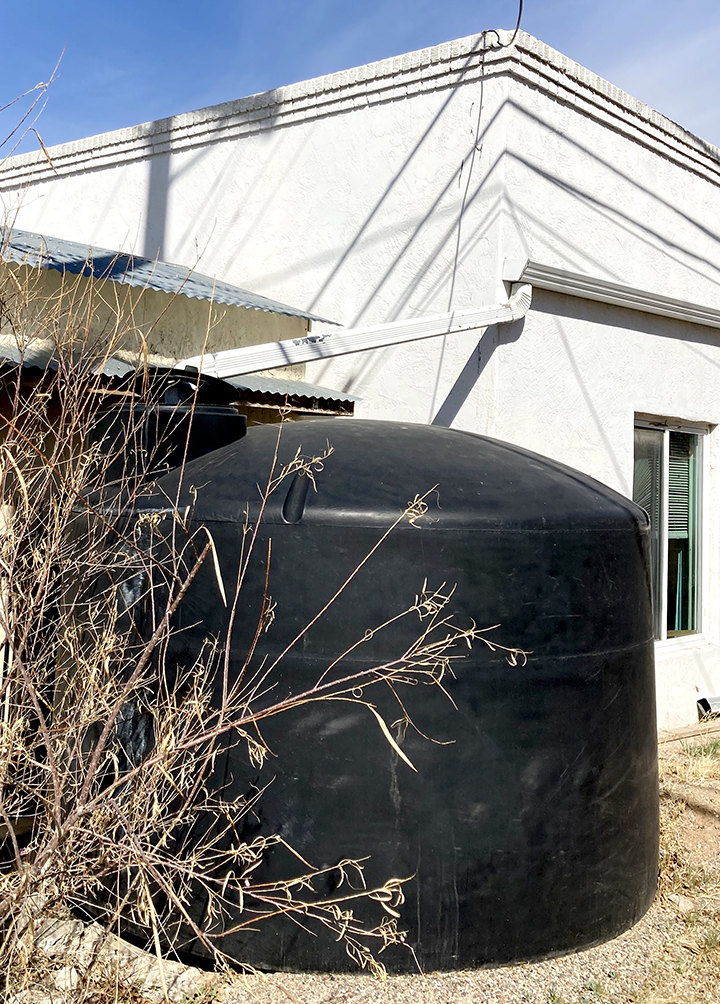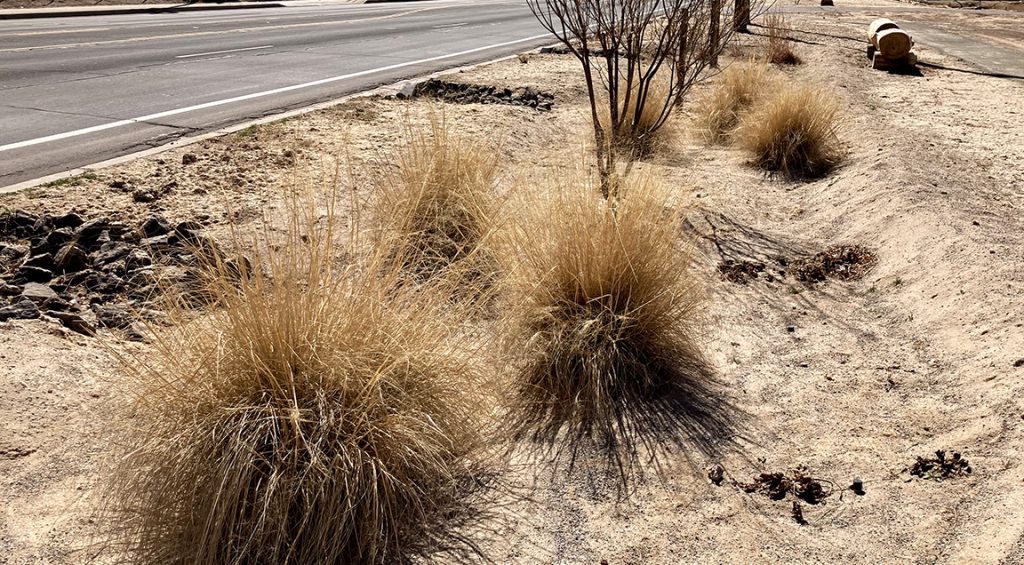
Permaculture is an approach to living with nature instead of trying to control it. It encourages us to repair our natural world. In a broader sense, permaculture is a re-organizing of how we do things. It is a design system. Specific practices such as water harvesting, building berms and swales, constructing French drains, and collecting grey water are all actions that apply permaculture principles. Most require some time and energy but are not costly. All are doable by anyone living on agriculture land, residential or commercial properties. Here is a start!
Water Harvesting
Water harvesting is a process to capture rain and move it to a different site rather than letting it become runoff. The practice is legal and encouraged in New Mexico. The water may be collected in a cistern for later use, directed to irrigate existing plant life, or channeled elsewhere on the property as a catchment area.

When using cisterns for water harvesting, gutters are placed along the roof line and downspouts direct the water into the cistern. To estimate the storage capacity needed for a cistern, take the square footage of the roof catchment area times the inches of average rainfall in a storm (in Albuquerque, ½ to 1”) times 0.623. This result is the number of gallons of storage you will need. Eighty-gallon cisterns are readily available in garden stores but larger fifteen-hundred gallon cisterns can also be purchased. Cisterns need to have a fine mesh over the top so leaf and other litter does not get in and clog the water outflow. The water should be used within a couple months so algae doesn’t start to grow in it.
French Drains
Building a French drain requires time, energy, and maybe a few friends to help you. This type of drain, named for a man with the last name of French, channels water from the catchment area directly to where you need it.
You begin by digging a trench from where water gathers to where you want it. It probably needs to be a foot wide and should descend an inch in depth for every eight feet of distance so that gravity can pull the water down to the desired location. (Careful attention to the incline is especially important if you have flat land.) A simple way to do this is to fill the trench with large gravel (three inch size, assorted). This type of drain ultimately fills up with dirt between the gravel, but roots find their way into the moist soil and nearby plant life can be supported.
If you want more control in directing rainwater, dig the trench deep enough to lay a barrier plastic liner, a layer of gravel, flexible corrugated plastic pipe, and then cover the trench with gravel. The pipe allows the water to flow out exactly where you want it, such as a ponding area. The uphill opening of the pipe needs to be covered with mesh to keep debris and dirt from getting in and clogging the pipe. Your local hardware store can help with advice and the things you need to buy for a French drain.
Berms and Swales

Berms and swales (trenches) are an important part of permaculture. They catch water on its downhill trajectory and let it sink into the ground rather than becoming runoff. Contour line(s) across the slope have to be marked. (YouTube has videos on making and using an A frame which will help you find the contours.) The distance between the contour lines depends on the pitch of the slope. For example, the steeper the slope, the more contours can be laid out to slow the speed of the water.
A trench is dug along the contour. Dirt is pulled forward onto the downhill side to make a little berm. Also, dead organic matter can be laid out on the contour before the dirt is pulled forward; then the berm can also act as a site for composting. In the Southwest, with so much sun causing evaporation, a light cover of brush over the swale may help retain the runoff water longer. Planting downhill from the berm allows the water to seep into the soil to support your plants’ root system.
Greywater
Greywater is the name used for wastewater from your house. (It does not include toilet water which is called black water.) It includes water from sinks, showers, and clothes washing machines. A conservative estimate of the amount of greywater an average person in Albuquerque puts out in a year is 5,400 gallons. A greywater system can capture and reuse much of this water when the property owner makes water conservation a priority.
The easiest source of greywater to capture is from a washing machine. The machine has enough force during its discharge cycle to push water to outside irrigation piping and therefore onto the soil. If on a slope, gravity can pull the water from showers, bathtubs, and handwashing sinks onto the land. Flood irrigation may be the best way to use the water from this source. Dishwasher water may have too much grease and food particles to be useful but some have found ways to filter this water and recycle it as well.
Care has to be taken when using greywater as it will have bacteria and chemicals. To decrease the chance for bacteria to thrive (causing an odor), the water must keep moving and sink into the soil soon. To decrease the chance for harmful chemicals to build up and change the soil, types of soaps and detergents must be used which do not for example contain phosphates.
Before embarking on a greywater system, it would be good to watch videos on YouTube by people who have experience with building these systems.
Classes on permaculture are offered by the Santa Fe Permaculture Institute, and farther north, people at Santa Clara Pueblo have developed the Flowering Tree Permaculture Institute, where they have been using various techniques on site for over 30 years. Some techniques found there which are more specific to our high desert location includes waffle gardens and nurse plants. If you want to get started applying permaculture principles to your land, there are these local resources and many more on the internet like Urban Farming. Good luck


This online magazine is a brilliant means of getting user-friendly, low-tech information out to all of us who desperately want to enact climate solutions in our daily and home lives! I admire the way the writers provide simple definitions for words that city-dwellers may not know. I’m benefiting from how you include such a variety of topics. You inspire me. In due time, I’d love to see articles about sustainability actions that apartment-building residents might take, in addition to shopping locally. We non-property owners are legion. We’re generally not wealthy. Often we’re temporary. We don’t see ourselves as having much political clout, and often we do not even know who our representatives are. Yet many of us want to be part of the solution rather than the problem. Hmm. Turn off water and electricity. Recycle plastics. Eat plant-based. What else?
Had not thought about writing an apartment dwelling article. Here are some suggestions in the meantime. Looking under INDEX, the article on container gardening might be helpful if you have a balcony and want to garden a little. Related to permaculture, there maybe an alley or some slopes off your apartment parking lot. Berms and swales would cut down the water runoff. You would have to borrow a hoe. Then a packet of local flower seeds or a few shrubs on the downside of the berm could be planted. This is a start to answer your question.